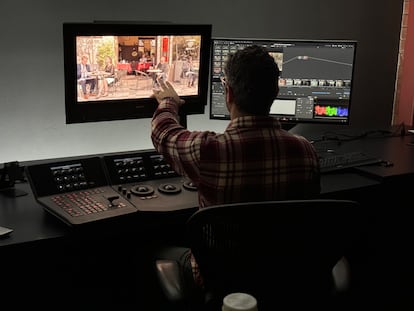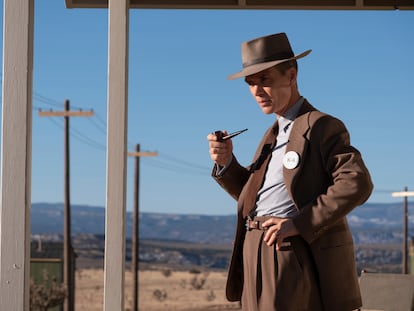The studio where ‘magic’ is made with Hollywood movies and series
Company 3 has been responsible for editing and post-production on hits like ‘Narcos,’ ‘Barbie’ and ‘Dune’


Barbie, The Hunger Games, Napoleon, and Dune have more in common than being some of the biggest movies released in recent years. All of them also passed through the hands of the professional colorists of Company 3, which is responsible for the post-production of 80% of Hollywood series and films, according to its founder and CEO Stefan Sonnenfeld, who has worked on productions of the caliber of Top Gun: Maverick, The White Lotus and Guardians of the Galaxy Vol. 3.
EL PAÍS visited the facilities of a Company 3 post-production studio in Los Angeles, meeting with Siggy Ferstl, a colorist who has worked on series such as Narcos, The Boys and Gen V as well as hundreds of commercials for Nike, Mercedes-Benz, Cadillac and other brands. While editing a scene from Gen V, he explains that he and other colorists receive direct footage from the films and series, shot with the original cameras. “Most of the time they shoot raw and then we edit and adapt it,” he explains.
Sometimes they simply enhance what was originally shot by modifying saturation and contrast. But if the director doesn’t like what was captured or wants to change it, experts like Ferstl can “colorize it and use visual effects. If it’s a simple drama and you’re just looking for a balance between scenes, the job can take 80 hours. But if you want a visual effects show, it can take 500,” he says.
To the eye of a non-technical observer, it looks like the colorists are using some sort of advanced Photoshop for movies. In addition to changing lighting and colors, they can go much further: blurring the background to enhance a part of the image, removing skin blemishes or imperfections, simulating the movement of a ship, or turning the original camera footage into a frightening and intimidating scene. For the latter, “sometimes it’s enough to make it darker and desaturate some colors, like blue,” says Ferstl.
Weather is an important factor to consider when planning a shoot. “When you take a scene shot outdoors for a week, the weather conditions can vary from moment to moment. One day it could be sunny and another day it could be cloudy. If we just put everything that was shot together, the lighting would be jarring,” says Ferstl. One of his jobs is to match it for consistency. Sometimes he is asked to simulate weather conditions. For example, to recreate a thunderstorm, he uses a flickering animation reminiscent of lightning.
Although one might think a colorist’s job is only to perfect the image, sometimes they seek the opposite: to degrade or dirty it. “Cameras are getting sharper and cleaner, so now a lot of the creative process can be about hiding details, because we have too much information captured,” says Cody Baker, a colorist who has worked on popular series including Space Force, Dopesick, Star Trek: Picard and Euphoria. Sometimes they give the image a kind of analog damage, as though it were on an old VHS tape or a black-and-white television, simulate that a scene has been recorded with a security camera, or add lens reflections.

Some changes are jaw-dropping. In a matter of seconds, Baker works magic. He transforms a scene shot on the street in broad daylight into a nighttime scene with low light cast by streetlights and car headlights. “Even though it can be done, it’s more believable when you shoot it at night because you can control all the shadows in real time and get a more realistic result,” he says.
Watching this studio’s colorists in action is a delight. They seem to be able to transform any scene into whatever they want. Ferstl fiddles with a scene in which a boy shoots up into the sky, spinning around. “It’s a visual effect. In reality, a crane was lifting him up with some wires that have been removed from the image,” he explains. He’s created a mask for the sky, as cloudy as it is cloudless, and strikingly blue.
On each project, Baker works hand-in-hand with the cinematographer and director of the film. For him, the most challenging aspect from a color perspective is “when you’re asked to transform it into something it’s not. There’s a limit to what you can do with an image. If you push it too far, it falls apart. It’s like it’s not meant to look that way.” For Baker, the most visually stunning projects are the ones that are framed and shot from the outset with a focus on color. This involves production design and cinematography. “If the scenes are captured beautifully, then we’ll make them a little more beautiful.”
What do people see in their homes?
In the rooms where both colorists work, there are several screens. One of the monitors is from Panasonic, the company that invited EL PAÍS to visit Company 3 in Los Angeles. “We also have professional monitors, [which cost] up to $40,000,” says Sonnenfeld, who is dressed in sneakers and a gray tracksuit. He speaks with approachability and looks like a modern CEO. As a colorist and business owner, he says he has always been frustrated because they have spent a lot of money on technical infrastructure, but until a few years ago they had no consumer equipment.
Now they work with Panasonic monitors: “Obviously, they are much cheaper, but at the same time they have very accurate colors and let us know what most people are going to see in their homes.” Toshiya Mizuno, Panasonic’s chief picture quality engineer, says the Japanese company has been working for years to improve picture quality and have its equipment used by Hollywood studios and post-production companies.
At Company 3, each room has between two and four monitors of different sizes. Mike Chiado, the company’s CTO, says that although they are different technologies, “they can measure anything and reproduce the same values on a standard TV set as on a giant screen costing thousands of dollars.” Still, he stresses that in the real world, not everyone sees colors in the same way. For him, this is where the work of professional colorists, who take this into account and have experience, sensitivity and, above all, photographic memory, is essential.
Sign up for our weekly newsletter to get more English-language news coverage from EL PAÍS USA Edition
Tu suscripción se está usando en otro dispositivo
¿Quieres añadir otro usuario a tu suscripción?
Si continúas leyendo en este dispositivo, no se podrá leer en el otro.
FlechaTu suscripción se está usando en otro dispositivo y solo puedes acceder a EL PAÍS desde un dispositivo a la vez.
Si quieres compartir tu cuenta, cambia tu suscripción a la modalidad Premium, así podrás añadir otro usuario. Cada uno accederá con su propia cuenta de email, lo que os permitirá personalizar vuestra experiencia en EL PAÍS.
¿Tienes una suscripción de empresa? Accede aquí para contratar más cuentas.
En el caso de no saber quién está usando tu cuenta, te recomendamos cambiar tu contraseña aquí.
Si decides continuar compartiendo tu cuenta, este mensaje se mostrará en tu dispositivo y en el de la otra persona que está usando tu cuenta de forma indefinida, afectando a tu experiencia de lectura. Puedes consultar aquí los términos y condiciones de la suscripción digital.
More information
Archived In
Últimas noticias
From digital curfews to blocking apps: How technology experts protect their children online
Why the price of coffee has skyrocketed: from Brazilian plantations to specialty coffee houses
Confined to a Cuban hospital: When electricity is a matter of life or death
How Japan is trying to avert ‘digital defeat’
Most viewed
- Pablo Escobar’s hippos: A serious environmental problem, 40 years on
- Reinhard Genzel, Nobel laureate in physics: ‘One-minute videos will never give you the truth’
- Why we lost the habit of sleeping in two segments and how that changed our sense of time
- Charles Dubouloz, mountaineering star, retires at 36 with a farewell tour inspired by Walter Bonatti
- The Florida Keys tourist paradise is besieged by immigration agents: ‘We’ve never seen anything like this’










































